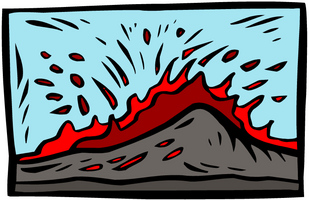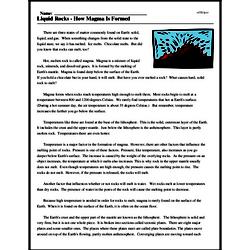Liquid Rocks - How Magma Is Formed
There are three states of matter commonly found on Earth: solid, liquid, and gas. When something changes from the solid state to the liquid state, we say it has melted. Ice melts. Chocolate melts. But did you know that rocks can melt, too?
Hot, molten rock is called magma. Magma is a mixture of liquid rock, minerals, and dissolved gases. It is formed by the melting of Earth's mantle. Magma is found deep below the surface of the Earth. If you hold a chocolate bar in your hand, it will melt. But have you ever melted a rock? What causes hard, solid rock to melt?
Magma forms when rocks reach temperatures high enough to melt them. Most rocks begin to melt at a temperature between 800 and 1200 degrees Celsius. We rarely find temperatures that hot at Earth's surface. (During a hot summer day, the air temperature is about 35 degrees Celsius.) But remember, temperature increases the farther you go below the surface.
Temperatures like these are found at the base of the lithosphere. This is the solid, outermost layer of the Earth. It includes the crust and the upper mantle. Just below the lithosphere is the asthenosphere. This layer is partly molten rock. Temperatures there are even hotter.
Temperature is a major factor in the formation of magma. However, there are other factors that influence the melting point of rocks. Pressure is one of these factors. Pressure, like temperature, also increases as you go deeper below Earth's surface. The increase is caused by the weight of the overlying rocks. As the pressure on an object increases, the temperature at which it melts also increases. This is why rock in the upper mantle usually does not melt. Even though temperatures are high enough, the pressure causes the melting point to rise. The rocks do not melt. However, if the pressure is released, the rocks will melt.




